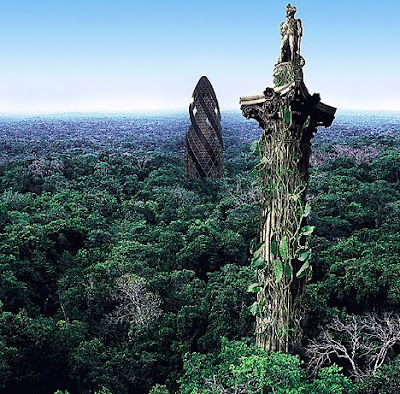Book Review—The World Without Us

The World Without Us asks the daunting question, “What would happen to the Earth if people vanished?” Not what would happen if we ruined the environment so completely we all went with it or if we blew ourselves up in an all-out nuclear war. Just that: disappeared. To get a rough idea of what it’d be like, Alan Weisman visited places that have become devoid of people (the no-man’s land between North and South Korea) and places that have never had people to begin with (the Bialowieza Puszcza, Europe’s only remaining old-growth forest) as well as Chambura Gorge and Gombe Stream, two islands of untouched land in North Africa that are “all that remain of the forest that birthed” the human race. What’s even more intriguing are the chapters (the meat of the book) where the author interviews experts on what might and will happen to specific places after we’re whisked away. Manhattan, for instance. I’ve walked all over it but never realized that 40 streams run under it. Never realized it because there are massive underground pumping stations that keep the island from flooding. Without humans, Manhattan would run riot with streams. Dogs would be wiped out by wild predators, but a few hardy cats would survive. Cockroaches, happily, would vanish, their source of artificial heat gone for good. The Statue of Liberty “will remain intact indefinitely…possibly encased in barnacles” below water level-the passage evokes scores of apocalyptic sci-fi movies.
We’ve been terrible stewards. That’s not breaking news. But how long will it take the planet to free itself of the CO2 we loaded it with? 100,000 years. We’re down and dirty all right. “The problem is, by tapping into Carboniferous Formation and spewing it up into the sky, we’ve become a volcano that hasn’t stopped erupting since the 1700s.” It may be said that we’ve blown it. And we’re too hot, too. How long will it take for glaciers to get on the move again? 15,000 years. How long will it take organisms to deal with the plastics we dump onto land and ocean? “Thousands of years, possibly. Or more.” There’s a lot of it on the ocean surface. On the Pacific is a thin layer of it almost as big as the continent of Africa, and that’s only one of seven giant collections that sit on the surface of the world’s oceans. How long will it take for all of this to biodegrade? Hundreds of millennia, a bit shorter if future life forms evolve into forms that can eat it. Without humans, there’ll be no pesticides. What would farmland look like to a human who could view a posthuman world in the South? “A Mississippi Delta fisherman…would be amazed at what he’d find.” Mount Rushmore? It’ll likely last 7.2 million years, long after virtually every visible trace of humankind is gone. What would a future intelligent species make of it? On a more mundane note, rodents and mongooses will take over most South Pacific islands. Another thing we’ve damaged is the planet’s UV screen. It’ll take an extremely long time for that to right itself. Meanwhile, those plants and animals “that remain in our wake will have to select for UV tolerance, or mutate their way through a barrage of electromagnetic radiation.”
The specific, almost palpable examples keep coming, in a relentless but fun way, gradually accumulating into bizarre and vivid, yet plausible, scenarios as Weisman creates a masterful long view. It never stops being stimulating, and often it’s enthralling.
What might be some of the longest-lasting human creations? “Hot glass bricks of nuclear waste.” Sound crazy? The half-life of the waste itself starts at 24,000 years. The U.S. Department of Energy Rocky Flats property is legally required to keep anyone (or any intelligent being) away from its nuclear waste for-yes-10,000 years. They’ve even come up with signs that are supposedly so universal that even a future humanoid that doesn’t speak any of today’s languages would still know it should stay away from the site. But if our descendents aren’t going to be here anyway, what the hey, no problem. As you may have suspected by now, the combined weight of these stories indirectly gives us plenty of incentive to clean our act up. By taking us out of the equation, the book puts us right back in it. After all, the way we’re headed we may well (as many scientists have been warning for decades) wipe ourselves out ecologically by the end of this century and thus induce something even worse than these scenarios. Sure, it’d be fun to watch the human-free scenes unfold. But without “us”, who’d do, or want to do, the watching? That’s just it. We need each other. We’re social creatures. However scarred and lavishly green a posthuman world would be, it’d be a lonely place indeed. The World Without Us has been called a Left Behind for seculars. That rather sells it short. It deserves and enormously wide audience and is maybe the most pleasant way of facing up to our responsibilities, and our legacy, that you could imagine.
Don't forget to check out the DVD Life After People, too.

Bialowieza Puszcza, showing a wisent, a European bison

Manhattan, 1609/2009
Review submitted by Richard Grooms, Social Science Dept., Central Library
Comments
Holley